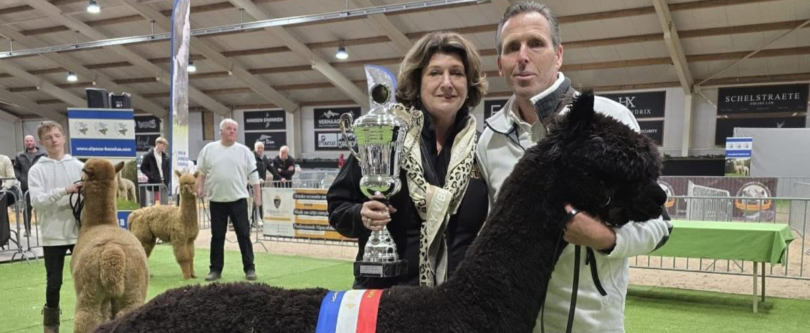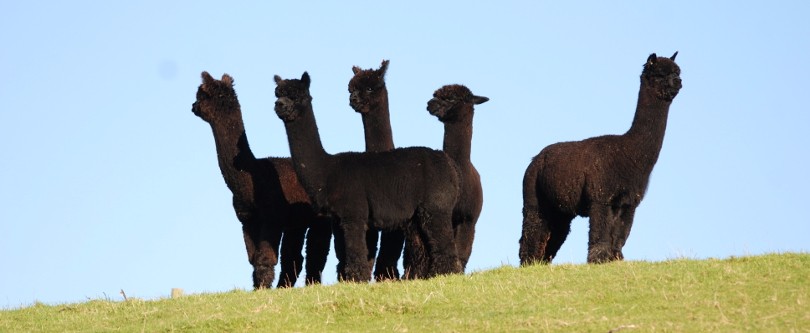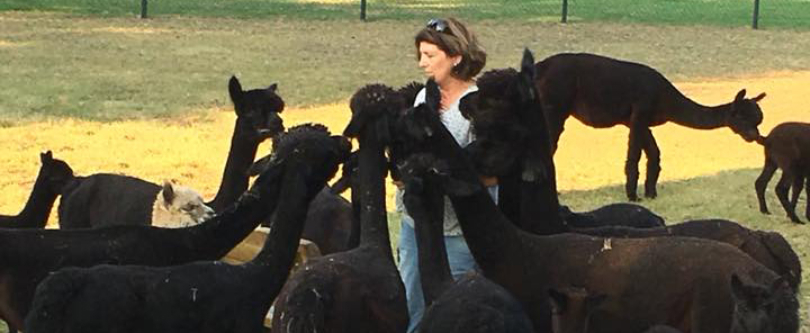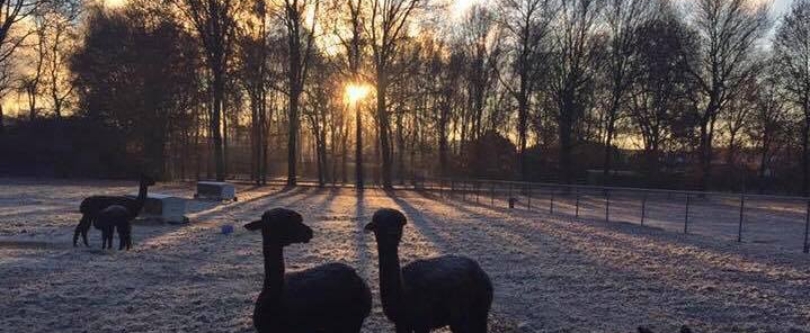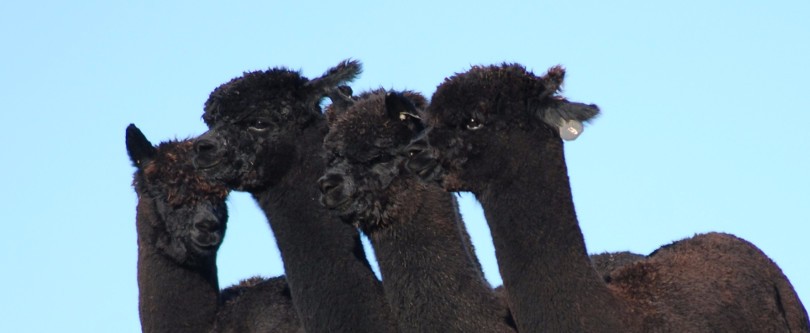Alpaca Fleece:

One of our stud males – Veko Farm Hasco
Alpaca fleece, described as ‘fibre of the Gods’ by the Incas of Peru is one of the worlds most precious fibres. Warmer and stronger than cashmere and softer and more lustrous than wool it is no wonder that alpaca fibre is in short demand. It is estimated that only 21% of the world market for alpaca fibre is currently being met. The bulk of the worlds alpaca fibre is being produced by Peru and Australia. Nearly all developed countries now have significant alpaca populations with a common goal to produce alpaca fibre for the international market. Prized by Italian designers the Italian fibre mills produce the best yarns in the world. London tailors use alpaca cloth to produce the finest suits and the Japanese spin and weave alpaca fibre with silk.
 The beauty of alpaca is that it comes in 16 natural colours ranging from pure white and cream, fawn, brown, grey and pure black, the only black fibre that does not need to be dyed.
The beauty of alpaca is that it comes in 16 natural colours ranging from pure white and cream, fawn, brown, grey and pure black, the only black fibre that does not need to be dyed.
To learn more about the finer points of alpaca fleece structure and why it has a huge market advantage over wool and cashmere please see below.
What we do with our fleece:
 Ruukin Kehräämö
Ruukin Kehräämö
Ruukin Kehräämö is a new and innovative Finnish company that are committed to the production of high quality fashion and home wares. They offer local and environmentally friendly products that are made with consideration to both animals and humans.

Shearing off the fleece at Tienda Molino
They feel a great responsibility to bring the natural fibre from the farm through to the finished product. They track the fibre from the back of the alpaca, first clip, processing of the yarn at the mill, manufacture of the products, labeling and finally sales.
We shear the fleece off here on our farm in April each year and at the same time the fleece is skirted, classed and then added to each grade ready for shipping to Finland.
The response to Ruukin Kehräämö products in the marketplace has been very exciting. They have won many awards and are making a huge impact with their sustainably farmed alpaca fibre.
Here at Tienda Molino we take great pride in being the leading supplier of high quality black fibre for Ruukki’s Spinning Mill
There are two types of alpacas:

The Huacaya alpaca grows a fleece with crimp

The Suri alpaca grows a fleece which has a wave and twist
Both of these alpacas have measurably high levels of fibre density and fibre length with fine primary fibres. The fleeces consist of many long, thin and clearly defined staples which are soft and lustrous. The crimp of the Huacaya alpaca has high amplitude and medium frequency. The Suri alpaca has gently wave and twisting locks.
Using visual selection for these fleece traits together with measurements of primary fibre diameter, fibre density and fibre length, the following changes have occurred over the last ten years in the herdsires selected for use in alpaca herds implementing this breeding system.
Our vision for the future
We have a vision that is shared by many breeders of black alpaca around the world. That vision is one day to breed and maintain a herd of black huacaya that clip a fleece of a weight and quality equal to the best white alpacas. By learning from the research and experience in the merino, angora and alpaca industry in Australia and North America we can improve breeding decisions and explore the link between nutrition, physiology, genetics and fibre. Our own experience tells us that our goal is attainable if we apply all that we have learnt and use males that consistently produce uniform progeny that carry the traits we desire together with using newly developed scientific breeding strategies that are proven to improve the annual clip while keeping a uniform black colour.

The alpaca fleece (left) has many guard hairs protruding from the outer fleece surface. The alpaca fleece (right) appears to be mostly free of guard hair.
Through the implimentation of advanced selection strategies we have been able to improve fleece quantity and quality whilst moving rapidly towards eliminating “guard hair”. Guard hairs are coarse and hollow centred primary fibres that form the outer coat on the fleeces of alpacas which tend to lack fibre density. Guard hairs do not absorb fabric dyes and spoil the appearance and handle of finished products.
The Animals and their fleeces
We breed alpacas which have very fine primary fibres (uniformity) and high levels of fibre density and length.
Very fine primary fibres ensure that the animals are free of guard hair. And because the wool follicles that produce very fine primary fibres require small numbers of pre-papilla cells to be involved in their construction during foetal development, more pre-papilla cells remain to be used in the formation of greater numbers of secondary wool follicles, thereby increasing the follicle and fibre density of the alpaca.
High fibre density
High fibre density brings to the Huacaya fleece an assembly of thin, not thick, staples with high crimp amplitude. The thin staples in the high density alpaca below are only about 3 mm wide and are approaching the ‘fibre bundle’ stage. In a low density alpaca, the staples can be very thick, as much as 40 mm wide.
The fibre bundle is the basic unit of fleece structure. It corresponds to the cluster of fibres produced from each follicle group in the animal’s skin. Similarly, the follicle group is the basic unit of follicle arrangement in the skin.
For a Huacaya alpaca which has exceptionally high fibre density (and length), fibre bundles will be abundantly visible throughout the fleece and these fibre bundles will be closely packed together and very long.

The fleece from an SRS® Merino ewe. Note that the fleece consists entirely of fibre bundles. Staples (locks) have disappeared.
It is the same phenomenon in Merino sheep, which like the Huacaya alpaca, produces wool fibres that crimp. The Merino fleece below consists entirely of fibre bundles, each about 1.5 millimetres wide (the same width as each follicle group in the skin). This fleece is from an adult Merino ewe which produced 8 kilograms of 16.0 micron wool for 12 months wool growth. Its fibre density is 120 follicles per square millimetre and its fibre length, 0.50 millimetres per day.
High density also brings to the Suri alpaca fleece an assembly of many staples that are consistently thin from base to tip (see photo below). On close inspection, fibre bundles can be seen emerging from the skin, only to twist together into thin staples. The thin staples need to be fast growing and gently coiling to allow easy fibre separation.
In both Huacayas and Suris, high density produces fibres that are highly aligned, fine in diameter, evenly sized and evenly shaped with smooth surfaces (low cuticle scale height). These features give the fleece its exceptional softness and with the high fibre alignment, its exceptional lustre.
High fibre length
High fibre length throughout the alpaca’s life is critically important to achieve genetically. There is an urgent need to correct the current industry situation worldwide where it is commonplace for alpacas to lose fibre length with age. The present situation is that fibre length decreases rapidly with age (also in Suris) and crimping time increases with age. This is typical of the condition known as ‘dogginess’. It is accompanied by a decrease in crimp frequency with ageing.
To overcome this problem, it is probably necessary to select for reduced crimping time whilst maximising fibre length. This is likely to give rise to alpacas which are efficient feed converters with well-organised blood networks to the wool follicles (the latter feature accompanies selection for high follicle density).
Currently our minimum requirement for fibre length of an adult Huacaya alpaca between 2 to 4 years of age is 0.35 millimetres per day with many selected animals now exceeding 0.40 millimetres per day. The industry norm is closer to 0.30 millimetres per day. Fibre length is greatest in fleeces which not only have long fleeces but also have high crimp amplitude and low crimp frequency.
If a semi circle is the maximum expression of a crimp wave, the fibres will be, on average, about 50% longer than the fleece. This high crimp amplitude is linked to high fibre elasticity and excellent drape in finished products. However, Huacayas, on average, have fibres that are only 11% longer than the fleece. The fibres are lazy and could be bred for much better elasticity and drape.
 |
Diagram of a single alpaca fibre. The vertical arrows indicate crimp amplitude. The horizontal arrows indicate crimp frequency. |
